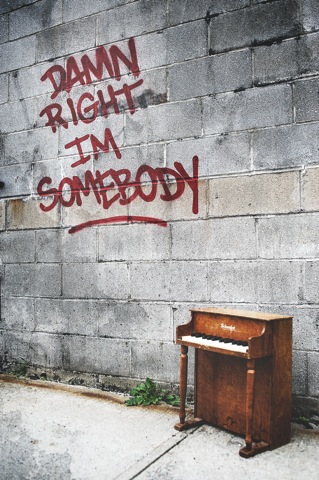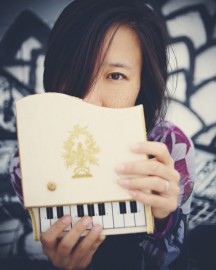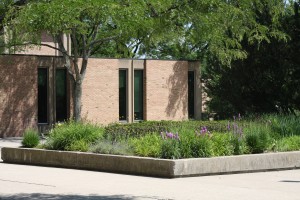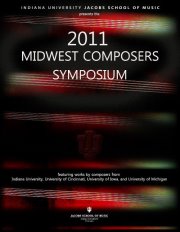
Breaking news from Cuernavaca, Mexico–Stefano Scodanibbio has passed away, a tremendous bassist, a fearless improviser, and a gifted composer. Faced with ALS, he decided to spend his last days in Mexico, a country he loved. I haven’t found any reports in English, but for those of you who speak Spanish, here’s the report. Google translation (not too bad) here.
Photo courtesy of Andre Penven for Coilhouse Magazine
Zoë Keating (Wow, what can I say??) has definitely cultivated a very respectable place in the new music and indie music circles. After rethinking a classical concert career as a cellist for working a tech job, she was intervened to perform with various friends, played in the band Rasputina, eventually went solo with a gorgeously layered, rhythmic cello sound. Zoë went on to sell over 40,000 copies of her CDs without distribution, a record label or management. And she has over one million Twitter followers. The internet loves her!
Besides her solo career, her other projects include music collaborations with various dance companies (Apex Contemporary Dance Theatre, American Repertory Ballet, Digby Dance), film scoring (or soundtrack performances; Warrior, The Secret Life of Bees, The Conspirator), scoring for varied TV programs and other medias, and makes guest appearances alongside artists such as Amanda Palmer, Paolo Nutini, Imogen Heap, and many more. (more…)

Elliott Carter is 103. The only composer who lived longer: Leo Ornstein. But Ornstein stopped composing at 97: Carter is still going.
On Thursday evening, in a concert at the 92nd Street Y organized by cellist Fred Sherry, seven works written since Carter’s 100th birthday were given their world or US premieres. Astounding.
S21’s intrepid reporter-in-the-field (oh yeah, and superstar violinist, too!) Hilary Hahn just happened to virtually bump into the dean of (very young) American composers, Nico Muhly. …Well, maybe there was a little advanced planning, but let’s keep this casual, shall we? Here they muck-de-muck for a friendly quarter-hour, about the musical life and the pieces Nico’s composed for Hilary.
[youtube]http://www.youtube.com/watch?v=1IBk_U6b2Hw[/youtube]

Think the emphasis should be placed on the first word of toy piano? If so, you’re behind the times! The repertoire and the number of toy piano performers are both steadily growing. And manufacturers like Schoenhut are custom designing and upgrading their toy pianos to make them viable for a plethora of special effects (check out David Smooke’s recent blog post over at NMB to learn more about various extended techniques the instrument is capable of enduring).

A commissioning project organized by Phyllis Chen and run since 2007, the Uncaged Toy Piano composition competition has worked on expanding the repertoire for toy piano. On November 29, December 1, and December 3, listeners will get to hear the fruits of the contestants’ labors. The Uncaged Toy Piano Festival showcases new pieces and several imaginative approaches to the baby grand’s spunky smaller cousin. In addition to Chen (and Smooke), the festival will feature toy piano diva Margaret Leng Tan, toy instrumentalist Angelica Negron, improvisor Miguel Frasconi, avant-folkies Cuddle Magic, and Rusty Banks’ Babbling Tower-to-Tower for toy piano and cell phones(!).
Uncaged Toy Piano Festival
November 29th, 7:30pm: Playhouse at Dixon
Dixon Place Lounge
161A Chrystie Street, New York City (Lower East Side)
December 1st, 8pm: Gershwin Hotel
7 East 27th Street, New York City (between 5th and Madison)
December 3rd, 8pm: Toy Bonanza
37 Arts The DiMenna Center
450 37th Street, New York, NY
 Early this week I posted my report on the 2011 Midwest Composers Symposium, wherein I mentioned the fact I had heard a lot of students’ music in a short amount of time. Well, the 30+ works I wrote about Thursday were just the beginning of my new music marathon because Midwest was immediately followed by last Monday’s student composers’ concert at the University of Michigan. That composers’ forum, the year’s second, was refreshingly brief in contrast to the preceding weekend’s protracted program, yet it contained delicious variety and a few personal debuts by composers I was not familiar with.
Early this week I posted my report on the 2011 Midwest Composers Symposium, wherein I mentioned the fact I had heard a lot of students’ music in a short amount of time. Well, the 30+ works I wrote about Thursday were just the beginning of my new music marathon because Midwest was immediately followed by last Monday’s student composers’ concert at the University of Michigan. That composers’ forum, the year’s second, was refreshingly brief in contrast to the preceding weekend’s protracted program, yet it contained delicious variety and a few personal debuts by composers I was not familiar with.
Monday’s concert began with an electro-acoustic work by Robert Alexander, an accomplished, technologically oriented composer/sound artist who I saw perform with the MiND Ensemble last Spring. Mr. Alexander’s piece, a line between two spaces (turning and turning and resting), featured composer David Biedenbender at the piano and a host of live electronic devices. As I gathered, the work was mainly improvised, though it seemed like the overall structure – mostly in terms of energy level – had been agreed on beforehand. Most remarkable about the piece is the way in which Mr. Alexander’s electronics interacted with the piano. At first, the piano’s sound is undistorted, with the first synthesized sounds regurgitating the piano’s music and then shifting the pitch ever so slightly. However, the electronics increasingly gain power over the piano, achieving a beautiful and stunning summit whereby the electronic part actually subsumes the acoustic space of the piano, and the instrument is no longer audible.
The next two pieces were beautiful songs performed by composers David Wolff (tenor) and Michael Schachter (pianist). First came Mr. Wolff’s “Of Mere Being”, an impressionistic setting of Wallace Stevens. With its impulsive musical moods, “Of Mere Being” reflects the text impeccably and expressively without being obvious. Moreover, Mr, Wolff’s performance, for both songs, was fantastic and demonstrative of his impressive musicianship. Mr. Schachter’s Pierrot (Heart), followed and didn’t shy away from the mantle of excellent vocal writing introduced carried by “Of Mere Being”. Pierrot sets a poem by Langston Hughes, and opens simply to establish a somber, contemplative space from which the narrator will tell his story. Like “Of Mere Being”, Pierrot merges the piano and singer into a single dramatic force that illustrates the text without being to transparent. Particularly important to the drama in Mr. Schachter’s work is the aforementioned simplicity of the opening material. This idea’s expressivity grows slowly, only to explode rather gloriously in the song’s captivating climax.

Time Out New York’s Steve Smith is sparing with the 5-star CD reviews, but he gave his highest score to Drawn Only Once, Due East’s New Amsterdam release. It features two beguiling multimedia works by John Supko, which feature video, electronics, Due East (Erin Lesser, flute and Greg Beyer, percussion), as well as a number of other instrumentalists and vocalists. These various elements are overlaid in a busy patchwork quilt, sometimes contemplative, at others dizzying: but it’s always a beguiling sound world. Despite the sometimes dense colloquy of events found on Drawn Only Once, the release will likely draw listeners back to fathom its depths in successive hearings.
Lesser and Beyer live in Wisconsin and Illinois, respectively. But on Monday night, they’re bringing Supko’s music to Galapagos Art Space, which will be bathed in the glow of video and the envelopment of surround sound.

Sharing the bill with them is another New Amsterdam artist – Gregory Spears – whose newly released Requiem is his debut CD. This is another disc that’s spent a lot of time in the short stack near my favorite listening spot, ready to be pressed into service for repeated hearings.
Spears combines early music instruments and singers with a 21st century aesthetic sensibility in a contemplation of mortality that eschews both dogmatism and morbidity. Although it’s a far more ambient motivated work than the Fauré Requiem, Spears’ essay in the genre shares a comforting and cautiously affirming demeanor with its predecessor, as well as a sensuousness of sound and intriguing modality that is most fetching.
Doors open at 7:00 and the show starts at 8.
Galapagos Art Space is located at 16 Main St, Dumbo, Brooklyn.
Call 718/222-8500 for more information.
 The positive aspect of having too much of a good thing is that you’ve consumed something good. For me in the last week, the object of my over-consumption has been new works by student composers, not only created by colleagues of mine at the University of Michigan, but the representatives of the University of Iowa, Indiana University and the University of Cincinnati who attended the 2011 Midwest Composers Symposium. Topping off the weekend-long buffet of freshly baked music was Monday evening’s second student composers’ concert of the year here at Michigan (which I will cover in the next installment in this pair of reviews). Suffice it to say, I heard a lot of music in those four days, so I will do my best to cover what passed by my ears.
The positive aspect of having too much of a good thing is that you’ve consumed something good. For me in the last week, the object of my over-consumption has been new works by student composers, not only created by colleagues of mine at the University of Michigan, but the representatives of the University of Iowa, Indiana University and the University of Cincinnati who attended the 2011 Midwest Composers Symposium. Topping off the weekend-long buffet of freshly baked music was Monday evening’s second student composers’ concert of the year here at Michigan (which I will cover in the next installment in this pair of reviews). Suffice it to say, I heard a lot of music in those four days, so I will do my best to cover what passed by my ears.
Midwest (as the event will be dubbed from now on) is an annually occurring conference of student composers held at one of the four member institutions (UM, UI, IU and CCM) on a rotating basis. For more background information check out last year’s post on the symposium. I participated in the Michigan delegation this year and traveled to Bloomington, Indiana (IU was the host this time ’round) with my work for two marimbas “Dark Spiral” (here’s a video). There were four concerts altogether, one Friday evening and three on Saturday offering over 30 individual works to an audience of composers, performers and professors. Intervening between the morning and afternoon concert Saturday was a very thought-provoking discussion session wherein each school elected students to give a brief presentation on a musical topic of their choice. I really enjoyed the interactions spawned by this feature of the event and I hope it is retained and, perhaps, expanded in the future.
I apologize in advance to all those performers and composers I am unable to devote much time to in the forthcoming paragraphs. The extreme volume of music presented to me forces me – understandably I hope – to be uncomfortably brief. Before getting specific I want to emphasize that every school represented themselves extremely well, in my opinion. Each offered a variety of styles and ensembles making the slate of proffered works as diverse as it was ample.
Now to the music.
Friday’s concert featured the “large ensemble” works, including performances by the Indiana University Chamber Orchestra, Contemporary Vocal Ensemble and New Music Ensemble. There were many remarkably beautiful moments in the first two works, Natalie Williams‘ Les Chant du Malador (2011) and Stas Omelchenko‘s Musings… (2011), particularly the third movement of Ms. Williams’ piece, which alludes to tonality in a very refracted way that is convincing and engaging without being too on-the-nose. These chamber orchestra works were followed by two very well-received (at least with my crew) choral pieces: Lindsey Jacob‘s Continue to Exist (2006) and Ji Young Kim‘s Reflections on Waiting for Mama (2011). Ms. Kim’s work is particularly striking in how it uses onomatopoeia to imitate the native language of her text’s subject, Korean. The piece balances the choir’s texture wonderfully, using precisely located solos to convey and magnify the work’s narrative backbone. The final two works on the evening’s program were Paul Dooley‘s Point Blank (which I already reviewed) and Justin Grossman‘s At Last the Secret is Out (2010), pairing very nicely together to conclude the first evening and set the bar very high for Saturday’s music.

Big news from Finland: Sketches of what appear to be Sibelius’s Eighth Symphony (long thought destroyed by Sibelius) have emerged. Here’s a clunky Google translation of the Finnish web site announcing this incredible discovery, along with an orchestral reading of those sketches. At the original Finnish link, you can access a video and hear the realization of the sketches. Those of you who don’t speak Finnish will want to jump ahead to ca. 2:00, where the music actually begins. Yes, it sounds like Sibelius, but a more chromatic and fragmented Sibelius than we’re accustomed to.
A more comfortably written article on the discovery and the musicology supporting the claim can be found here.
And a great big Thank You to Sibelius booster Alex Ross, who hipped me to this at his web site.
[youtube]http://www.youtube.com/watch?v=0OX_4cJyhgI[/youtube]